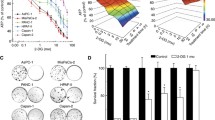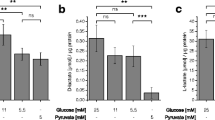Abstract
Tumor cells have a high tolerance for acidic and hypoxic microenvironments, also producing abundant lactic acid through accelerated glycolysis in the presence or absence of O2. While the accumulation of lactate is thought to be a major contributor to the reduction of pH-circumscribing aggressive tumors, it is not known if other endogenous metabolic products contribute this acidity. Furthermore, anaerobic metabolism in cancer cells bears similarity to homo-fermentative lactic acid bacteria, however very little is known about an alternative pathway that may drive adenosine triphosphate (ATP) production independent of glycolysis. In this study, we quantify over 40 end-products (amines, acids, alcohols, aldehydes, or ketones) produced by malignant neuroblastoma under accelerated glycolysis (+glucose (GLU) supply 1–10 mM) ± mitochondrial toxin; 1-methyl-4-phenylpyridinium (MPP+) to abate aerobic respiration to delineate differences between anaerobic vs. aerobic cell required metabolic pathways. The data show that an acceleration of anaerobic glycolysis prompts an expected reduction in extracellular pH (pHex) from neutral to 6.7 ± 0.006. Diverse metabolic acids associated with this drop in acidity were quantified by ionic exchange liquid chromatography (LC), showing concomitant rise in lactate (Ctrls 7.5 ± 0.5 mM; +GLU 12.35 ± 1.3 mM; +GLU + MPP 18.1 ± 1.8 mM), acetate (Ctrl 0.84 ± 0.13 mM: +GLU 1.3 ± 0.15 mM; +GLU + MPP 2.7 ± 0.4 mM), fumarate, and a-ketoglutarate (<10 µM) while a range of other metabolic organic acids remained undetected. Amino acids quantified by o-phthalaldehyde precolumn derivatization/electrochemical detection–LC show accumulation of l-alanine (1.6 ± .052 mM), l-glutamate (285 ± 9.7 µM), l-asparagine (202 ± 2.1 µM), and l-aspartate (84.2 ± 4.9 µM) produced during routine metabolism, while other amino acids remain undetected. In contrast, the data show no evidence for accumulation of acetaldehyde, aldehydes, or ketones (Purpald/2,4-dinitrophenylhydrazine—Brady's reagent), acetoin (Voges–Proskauer test), or alcohols (NAD+-linked alcohol dehydrogenase). In conclusion, these results provide preliminary evidence to suggest the existence of an active pyruvate–alanine transaminase or phosphotransacetylase/acetyl-CoA synthetase pathway to be involved with anaerobic energy metabolism of cancer cells.





Similar content being viewed by others
References
Agren D, Stehr M, Berthold CL, Kapoor S, Oehlmann W, Singh M, et al. Three-dimensional structures of apo- and holo-l-alanine dehydrogenase from Mycobacterium tuberculosis reveal conformational changes upon coenzyme binding. J Mol Biol. 2008;377:1161–73.
Airley RE, Mobasheri A. Hypoxic regulation of glucose transport, anaerobic metabolism and angiogenesis in cancer: novel pathways and targets for anticancer therapeutics. Chemotherapy. 2007;53:233–56.
Armstrong FB. Biochemistry. 2nd ed. New York: Oxford University Press; 1983. p. 184–5. 270–271, 283, 285.
Biedler JL, Roffler-Tarlov S, Schachner M, Freedman LS. Multiple neurotransmitter synthesis by human neuroblastoma cell lines and clones. Cancer Res. 1978;38:3751–7.
Bongaerts GP, van Halteren HK, Verhagen CA, Wagener DJ. Cancer cachexia demonstrates the energetic impact of gluconeogenesis in human metabolism. Med Hypotheses. 2006;67:1213–22.
Carman AJ, Vylkova S, Lorenz MC. Role of acetyl coenzyme A synthesis and breakdown in alternative carbon source utilization in Candida albicans. Eukaryot Cell. 2008;7:1733–41.
Darling TN, Davis DG, London RE, Blum JJ. Products of Leishmania braziliensis glucose catabolism: release of d-lactate and, under anaerobic conditions, glycerol. Proc Natl Acad Sci U S A. 1987;84:7129–33.
Davidow A, Kanaujia GV, Shi L, Kaviar J, Guo X, Sung N, et al. Antibody profiles characteristic of Mycobacterium tuberculosis infection state. Infect Immun. 2005;73:6846–51.
De Milito A, Fais S. Tumor acidity, chemoresistance and proton pump inhibitors. Future Oncol. 2005;1:779–86.
Feala JD, Coquin L, McCulloch AD, Paternostro G. Flexibility in energy metabolism supports hypoxia tolerance in Drosophila flight muscle: metabolomic and computational systems analysis. Mol Syst Biol. 2007;3:99.
Finklestein JZ, Tittle K, Meshnik R, Weiner J. Murine neuroblastoma: further evaluation of the C1300 model with single antitumor agents. Cancer Chemother Rep. 1975;59:975–83.
Gallagher DT, Monbouquette HG, Schröder I, Robinson H, Holden MJ, Smith NN. Structure of alanine dehydrogenase from Archaeoglobus: active site analysis and relation to bacterial cyclodeaminases and mammalian mu crystallin. J Mol Biol. 2004;342:119–30.
Guillermo G. Improvement of Escherichia coli production strains by modification of the phosphoenolpyruvate: sugar phosphotransferase system. Microb Cell Fact. 2005;4:14.
Hashimoto SI, Katsumata R. Mechanism of alanine hyperproduction by Arthrobacter oxydans HAP-1: metabolic shift to fermentation under nongrowth aerobic conditions. Appl Environ Microbiol. 1999;65:2781–3.
Herrmann PC, Herrmann EC. Oxygen metabolism and a potential role for cytochrome c oxidase in the Warburg effect. J Bioenerg Biomembr. 2007;39:247–50.
Johnson AB, Denko N, Barton MC. Hypoxia induces a novel signature of chromatin modifications and global repression of transcription. Mutat Res. 2008;640:174–9.
Kawanaka M, Matsushita K, Kato K, Ohsaka A. Glucose metabolism of adult Schistosoma japonicum as revealed by nuclear magnetic resonance spectroscopy with d-[13C6]glucose. Physiol Chem Phys Med NMR. 1989;21:5–12.
Kim JW, Gao P, Liu YC, Semenza GL, Dang CV. Hypoxia-inducible factor 1 and dysregulated c-Myc cooperatively induce vascular endothelial growth factor and metabolic switches hexokinase 2 and pyruvate dehydrogenase kinase 1. Mol Cell Biol. 2007;27:7381–93.
Kleerebezemab M, Holsa P, Hugenholtza J. Lactic acid bacteria as a cell factory: rerouting of carbon metabolism in Lactococcus lactis by metabolic engineering. Enzyme Microbial Tech. 2000;26:840–8.
Koukourakis MI, Giatromanolaki A, Sivridis E, Gatter KC, Harris AL, Tumour Angiogenesis Research Group. Lactate dehydrogenase 5 expression in operable colorectal cancer: strong association with survival and activated vascular endothelial growth factor pathway—a report of the Tumour Angiogenesis Research Group. J Clin Oncol. 2006;24:4301–8.
Koukourakis MI, Giatromanolaki A, Bougioukas G, Sivridis E. Lung cancer: a comparative study of metabolism related protein expression in cancer cells and tumor associated stroma. Cancer Biol Ther. 2007;6:1476–9.
Lee SG, Liao JC. Control of acetate production rate in Escherichia coli by regulating expression of single-copy pta using lacQ in multicopy plasmid. J Microbiol Biotechnol. 2008;18:334–7.
Lee M, Smith GM, Eiteman MA, Altman E. Aerobic production of alanine by Escherichia coli aceF ldhA mutants expressing the Bacillus sphaericus alaD gene. Appl Microbiol Biotechnol. 2004;65:56–60.
Márquez J, Sánchez-Jiménez F, Medina MA, Quesada AR, Núñez de Castro I. Nitrogen metabolism in tumor bearing mice. Arch Biochem Biophys. 1989;268(2):667–75.
Mazzio EA, Soliman KF. Effects of enhancing mitochondrial oxidative phosphorylation with reducing equivalents and ubiquinone on 1-methyl-4-phenylpyridinium toxicity and complex I–IV damage in neuroblastoma cells. Biochem Pharmacol. 2004;67(6):1167–84.
Mekhail K, Khacho M, Gunaratnam L, Lee S. Oxygen sensing by H+: implications for HIF and hypoxic cell memory. Cell Cycle. 2004;3:1027–9.
Montero VM, Wright LS, Siegel F. Increased glutamate, GABA and glutamine in lateral geniculate nucleus but not in medial geniculate nucleus caused by visual attention to novelty. Brain Res. 2001;916:152–8.
Mugula JK, Nnko SA, Narvhus JA, Sørhaug T. Microbiological and fermentation characteristics of togwa, a Tanzanian fermented food. Int J Food Microbiol. 2003;80:187–99.
Ozkan P, Mutharasan R. A rapid method for measuring intracellular pH using BCECF-AM. Biochim Biophys Acta. 2002;1572(1):143–8.
Panagou EZ, Schillinger U, Franz CM, Nychas GJ. Microbiological and biochemical profile of cv. Conservolea naturally black olives during controlled fermentation with selected strains of lactic acid bacteria. Food Microbiol. 2008;25:348–58.
Pastorekova S, Zatovicova M, Pastorek J. Cancer-associated carbonic anhydrases and their inhibition. Curr Pharm Des. 2008;14:685–98.
Rafailidis PI, Kapaskelis A, Christodoulou C, Galani E, Falagas ME. Concurrent M. tuberculosis, Klebsiella pneumoniae, and Candida albicans infection in liver metastasis of bowel carcinoma. Eur J Clin Microbiol Infect Dis. 2008;27:753–5.
Ragsdale SW. Enzymology of the wood–Ljungdahl pathway of acetogenesis. Ann N Y Acad Sci. 2008;1125:129–36.
Ravot G, Ollivier B, Fardeau ML, Patel BK, Andrews KT, Magot M, et al. l-Alanine production from glucose fermentation by hyperthermophilic members of the domains bacteria and Archaea: a remnant of an ancestral metabolism? Appl Environ Microbiol. 1996;62:2657–9.
Silva BM, Andrade PB, Mendes GC, Seabra RM, Ferreira MA. Study of the organic acids composition of quince (Cydonia oblonga Miller) fruit and jam. J Agric Food Chem. 2002;50:2313–7.
Starck J, Källenius G, Marklund BI, Andersson DI, Akerlund T. Comparative proteome analysis of Mycobacterium tuberculosis grown under aerobic and anaerobic conditions. Microbiology. 2004;150:3821–9.
Takahashi H, McCaffery JM, Irizarry RA, Boeke JD. Nucleocytosolic acetyl-coenzyme a synthetase is required for histone acetylation and global transcription. Mol Cell. 2006;23:207–17.
Ugurbil K, Brown TR, den Hollander JA, Glynn P, Shulman RG. High-resolution 13C nuclear magnetic resonance studies of glucose metabolism in Escherichia coli. Proc Natl Acad Sci U S A. 1978;75:3742–6.
Wada M, Narita K, Yokota A. Alanine production in an H+-ATPase- and lactate dehydrogenase-defective mutant of Escherichia coli expressing alanine dehydrogenase. Microbiol Biotechnol. 2007;76:819–25.
Wahl ML, Owen JA, Burd R, Herlands RA, Nogami SS, Rodeck U, et al. Regulation of intracellular pH in human melanoma: potential therapeutic implications. Mol Cancer Ther. 2002;1:617–28.
Walenta S, Schroeder T, Mueller-Klieser W. Lactate in solid malignant tumors: potential basis of a metabolic classification in clinical oncology. Curr Med Chem. 2004;11:2195–204.
Yoshii Y, Furukawa T, Yoshii H, Mori T, Kiyono Y, Waki A, et al. Cytosolic acetyl-CoA synthetase affected tumor cell survival under hypoxia: the possible function in tumor acetyl-CoA/acetate metabolism. Cancer Sci. 2009;100:821–7.
Ziello JE, Jovin IS, Huang Y. Hypoxia-inducible factor (HIF)-1 regulatory pathway and its potential for therapeutic intervention in malignancy and ischemia. Yale J Biol Med. 2007;80:51–60.
Author information
Authors and Affiliations
Corresponding author
Rights and permissions
About this article
Cite this article
Mazzio, E.A., Smith, B. & Soliman, K.F.A. Evaluation of endogenous acidic metabolic products associated with carbohydrate metabolism in tumor cells. Cell Biol Toxicol 26, 177–188 (2010). https://doi.org/10.1007/s10565-009-9138-6
Received:
Accepted:
Published:
Issue Date:
DOI: https://doi.org/10.1007/s10565-009-9138-6




